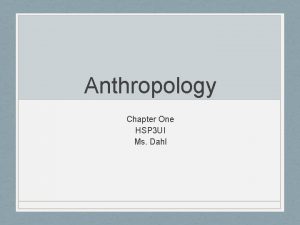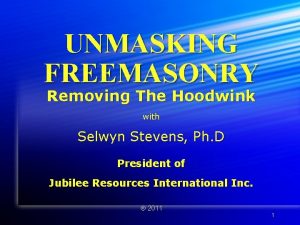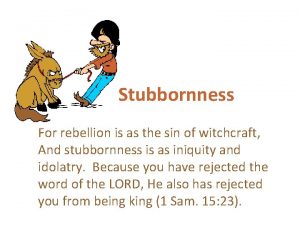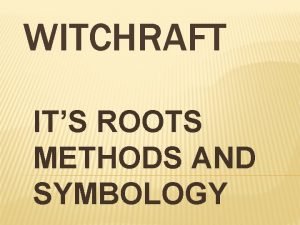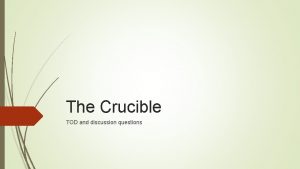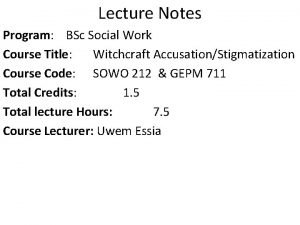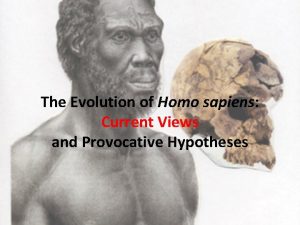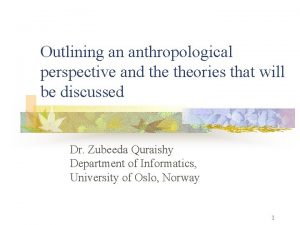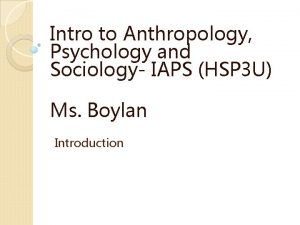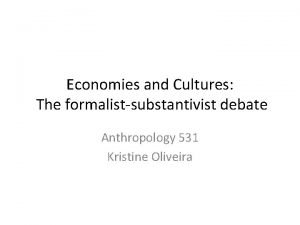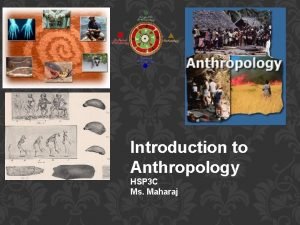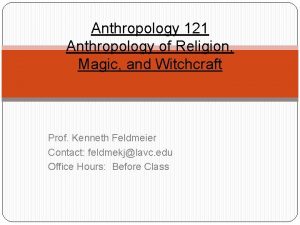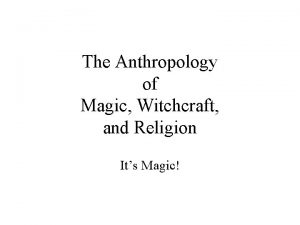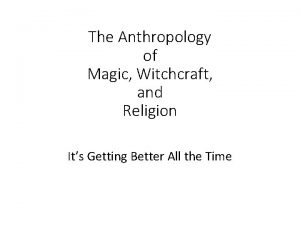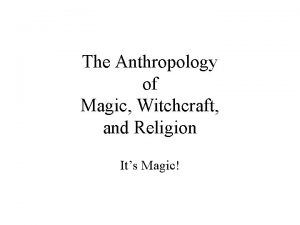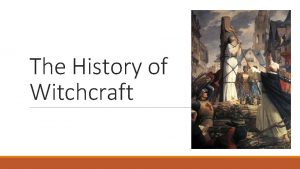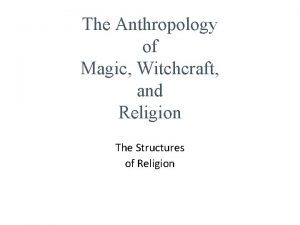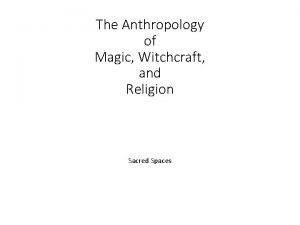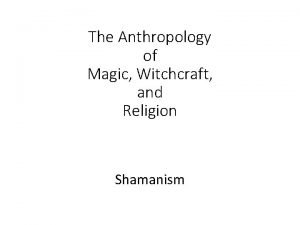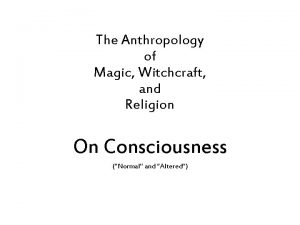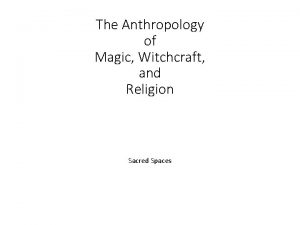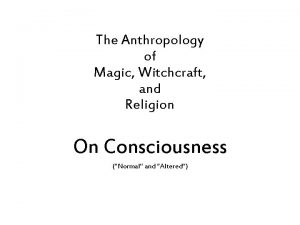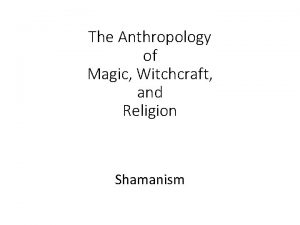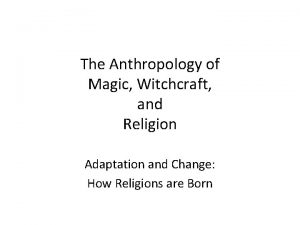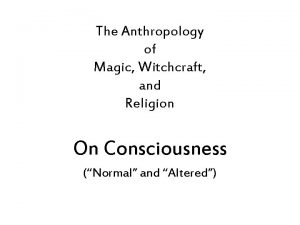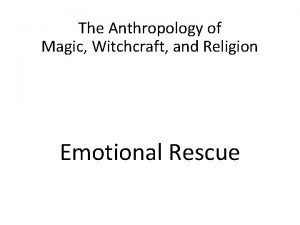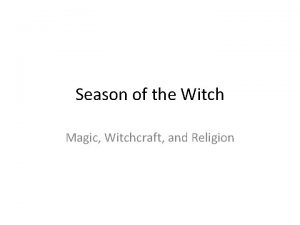The Anthropology of Magic Witchcraft and Religion Its











































- Slides: 43

The Anthropology of Magic, Witchcraft, and Religion It’s Getting Better All the Time? Hinduism

The Hindu Trimurthi

Central Concepts of Hinduism (pantheon) • Brahman – a term used to refer to the one, indivisible, ultimate reality, of which māyā is the manifestation • Ātman – the manifestation of Brahman within the individual (approximates the English term “soul”)

Central Concepts of Hinduism (substantive beliefs) • māyā – etymologically related to “measure” (root mā – “to measure, lay out, produce, create, display”) māyā is existence

Central Concepts of Hinduism (substantive beliefs) • dharma – “duty”, “what you must do” • karma – a universal law of cause and effect all beings are born and reborn in positions that are at least partially determined by the results of their past actions

Krishna teaching Arjuna (from the Bhagavad Gita (part of the Mahabharata)


Central Concepts of Hinduism (substantive beliefs) The aim of Indian thought is to learn that māyā exists and to cut through its webs of deception. In doing so, a person attains a reality which truly is reality. moksha – the liberation that results when a person understands the nature of the cycle of birth, death, and rebirth

What drives the cycle of birth, death, and rebirth? • ignorance • desire • attachment

In Hinduism unreality = all that is everchanging, transitory, elusive, and ever-returning reality = that which is changeless, imperishable, steadfast, and eternal That which cannot be comprehended by mind but by which the mind is comprehended – know that alone to be supreme being and not this or that god whom people ordinarily worship Kenopanishad – P. 1. 5 (ca. 600 B. C. E. )

Hinduism • a cyclical view of the world • cycles embedded in cycles • each world cycle has four world ages (yuga) v krita v treta v dvapara v kali

krita yuga (the “four-quartered” yuga ) • dharma stands on four legs, like the sacred cow • all beings follow their dharma of their own accord, all are virtuous • lasts for 1, 728, 000 years

treta yuga (the “three-quartered” yuga ) • the power of dharma stands on three legs • order is loosing ground • the observance of duty is no longer automatic, but must be learned • lasts for 1, 296, 000 years

dvapara yuga (the “two-quartered” yuga ) • dharma stands on two legs • a dangerous balance between perfection and imperfection, dark and light • knowledge of the divine is increasingly lost • true spirituality is disappearing, and can only be attained through fasting, vows, devotion, etc. • lasts for 864, 000 years

kali yuga (the “one-quartered” yuga ) • only ¼ of the original dharma is being observed • egotism, blind and reckless qualities prevail • humans and the world of humans are at their worst • lasts for 432, 000 years

kali yuga • began on Friday, February 18, 3102 B. C. E. • over 427, 000 years remain in the current yuga

maha yuga (the “great” yuga ) krita yuga 1, 728, 000 years treta yuga 1, 296, 000 years dvapara yuga kali yuga 864, 000 years 432, 000 years _______ maha yuga 4, 320, 000 years

Cycles of Existence • 1 maha yuga = 4, 320, 000 years • 1 kalpa (day of Brahma) = 1000 maga yuga = 4, 320, 000 years • each kalpa consists of 14 manvantaras (intervals of Manu), each of which ends in a great flood • we are currently in the 7 th manvantara of the present day of Brahma

Cycles of Existence At the dawn of each kalpa, Brahma reemerges from a lotus which grows from the navel of Vishnu

Cycles of Existence At night, Brahma and all within him disappear for a period as long as one Brahma day

Cycles of Existence • after 100 years of Brahma days and nights, all is dissolved. • The three visible worlds (earth, heaven, and the space between) disappear, as do all the spheres of being • all is reabsorbed into the divine primeval substance

Cycles of Existence • this state lasts as long as one life of Brahma (a century of Brahma) • = 311, 040, 000, 000 years


Emotional Rescue

Buddhism • founded by Siddhārtha Gautama, a prince from the Himalayan foothills (ca. 566 -480 B. C. E. ) • Gautama’s mother, Māyā, dreamed that a white elephant descended from heaven and entered her womb

Gautama • The priests consulted to interpret this dream told the parents that the son would either be a great king or become a great monk, depending upon what he experienced • Gautama’s mother died soon after giving birth

Gautuma • Gautama’s father sequestered his son from the world, and took steps to ensure that he only experienced happiness and beauty • Gautama married the most desirable princess of the land • Together, they had a beautiful son • But Gautama became bored with life

Gautama • The gods, aware that Gautama was destined to be the Buddha, were dismayed at the king’s behavior • They agreed that a deva (god) would appear to Gautama to help bring him to his path • The deva appeared to Gautama when he left the palace

The “Four Signs” • on the 1 st day, the deva appeared as an old man • on the 2 nd day, the deva appeared as a sick person • on the 3 rd day, the deva appeared as a corpse • on the 4 th day, the deva appeared as a sannyasin, a wandering monk

Gautama’s Quest • Gautama leaves his life of privilege and wealth for a spiritual pursuit • The “renounciation”

Gautama’s Quest • he wandered for years, studied with many sages, and learned a wide variety of spiritual practices • meditation • fasting • asceticism

Gautama’s Quest • After many years, Gautama finally realized that no teacher could lead him to the fulfillment of his quest, but that he had to attain it on his own • The “middle path”

Gautama’s Quest • One day, he came to the Bodhi tree • He vowed to remain there until he either died or attained enlightenment • Gautama began to meditate the “tree of enlightenment” (Ficus religiosus)

Gautama’s Quest • Mara, the “tempter” (who uses desire, fear, distraction), attempts to divert him from his quest • he appears as a messenger with sad news from his home • he sends his three beautiful daughters to seduce him • by challenging his generosity but Gautama is not diverted

3 Stages of Enlightenment 1. Gautama gains knowledge of his prior lives and states 2. 3. His “third eye” of omniscient vision opens He understands from within the “chain of causation” Gautama becomes the Buddha, the “Enlightened One”

The “Four Noble Truths” 1. that existence coincides with dukkha (pain, suffering) 2. that dukkha has a cause 3. that dukkha also has a cessation 4. that there is a path which leads to the cessation of dukkha

The “Eight-Fold Path” 1. 2. 3. 4. 5. 6. 7. 8. 1 & 2: focus on attitude right views right aspiration 3, 4, 5 & 6: focus on behavior right speech right action right means of livelihood 7 & 8: focus on the meditative dimensions right effort of human life right awareness right concentration

Buddha’s Teachings • therapeutic in nature • the normal condition of the organism is health; a doctor works to remove the obstacles to health • our normal spiritual state is also one of health; when a person takes refuge in a viewpoint (= dogma), then the fever of desire burns

Buddha’s Teachings • the three poisons which feed the flame of selfishness are: • Ignorance • Desire • Fear (of loss of attachment) • Nirvana is the state in which this flame is extinguished • Once the flame is extinguished, there will be no rebirth

Buddha’s Teachings • Buddha did not concern himself with metaphysics, but with the phenomena of existence • There is no “first cause” or “god” – a meaningless concept • The teachings are like a raft used to cross a river – once you have crossed, you do not need them (and thus should abandon them)

“When one gives up trying to understand, then one may be enlightened” Nagarjuna


You Are Cordially Invited to Attend The Anthropology of Magic, Witchcraft, and Religion For an Emotional Rescue
 Hufflepuff timetable
Hufflepuff timetable Anthropology and its branches
Anthropology and its branches Secneer
Secneer Ammi ruhamah freemason
Ammi ruhamah freemason Stubbornness is as witchcraft
Stubbornness is as witchcraft No witchcraft for sale theme
No witchcraft for sale theme What is the python spirit
What is the python spirit Prayer points elisha goodman
Prayer points elisha goodman What does elizabeth do when called upon to testify? *
What does elizabeth do when called upon to testify? * Witchcraft symbology
Witchcraft symbology American academy of witchcraft arts
American academy of witchcraft arts The crucible act 1 discussion questions
The crucible act 1 discussion questions No witchcraft for sale
No witchcraft for sale Elizabeth proctor quotes
Elizabeth proctor quotes Bsc witchcraft
Bsc witchcraft No witchcraft for sale summary
No witchcraft for sale summary Emigree poem analysis
Emigree poem analysis Its halloween its halloween the moon is full and bright
Its halloween its halloween the moon is full and bright Lumpers and splitters anthropology
Lumpers and splitters anthropology 3 main components of anthropological perspective
3 main components of anthropological perspective Introduction to anthropology psychology and sociology
Introduction to anthropology psychology and sociology Formalist and substantivist debate
Formalist and substantivist debate Venn diagram of psychology and sociology
Venn diagram of psychology and sociology Hsp3c
Hsp3c What is anthropology
What is anthropology When a train increases its velocity, its momentum
When a train increases its velocity, its momentum Cloudy windy rainy sunny
Cloudy windy rainy sunny If its a square it's a sonnet summary
If its a square it's a sonnet summary Its not easy but its worth it
Its not easy but its worth it Hát kết hợp bộ gõ cơ thể
Hát kết hợp bộ gõ cơ thể Lp html
Lp html Bổ thể
Bổ thể Tỉ lệ cơ thể trẻ em
Tỉ lệ cơ thể trẻ em Chó sói
Chó sói Thang điểm glasgow
Thang điểm glasgow Chúa yêu trần thế
Chúa yêu trần thế Môn thể thao bắt đầu bằng chữ f
Môn thể thao bắt đầu bằng chữ f Thế nào là hệ số cao nhất
Thế nào là hệ số cao nhất Các châu lục và đại dương trên thế giới
Các châu lục và đại dương trên thế giới Cong thức tính động năng
Cong thức tính động năng Trời xanh đây là của chúng ta thể thơ
Trời xanh đây là của chúng ta thể thơ Mật thư anh em như thể tay chân
Mật thư anh em như thể tay chân Làm thế nào để 102-1=99
Làm thế nào để 102-1=99 độ dài liên kết
độ dài liên kết

